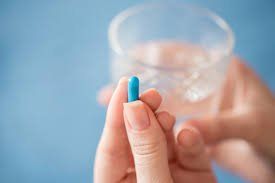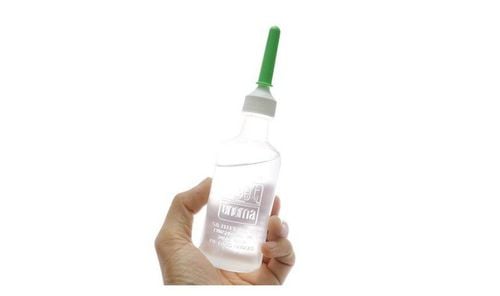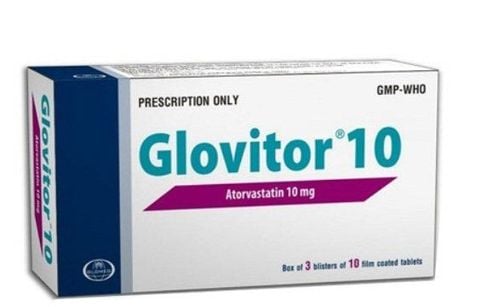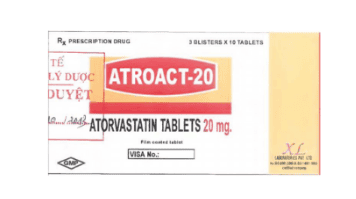This is an automatically translated article.
Fenostad 200 contains the active ingredient fenofibrate and is available in the form of a hard capsule packaged in blister packs. The drug is indicated for the treatment of types IIa, IIb, III, IV and V dyslipoproteinemia in combination with diet. Let's learn about the side effects and notes when using Fenostad 200 through the article below.
1. What are the uses of Fenostad 200mg?
Fenostad is indicated in the support of diets and non-drug weight loss treatment regimens.
Increased blood cholesterol, severe hypertriglyceridemia, mixed hyperlipidemia when diet is not effective. The previous diet and weight loss must still be treated. Hyperlipoproteinemia secondary to or persistent despite treatment of the cause, as in diabetes mellitus.
2. Dosage of the drug Fenostad 200
Fenostad should be taken whole with a glass of water and with meals. However, it is still advisable to continue with the diet that was used before using the drug. Regularly monitor serum lipid values during treatment. If there is no adequate response after 3 months, then additional or other therapeutic measures should be considered.
In adults: The recommended initial dose is 1 tablet per day with a main meal. If you are taking fenofibrate 200mg capsules, you can change to 1 fenofibrate 160mg tablet without any dose adjustment. Elderly: Elderly patients without renal impairment are advised to use the adult dose. Renal impairment: In this case, the dose should be reduced, and patients with chronic kidney disease should not take fenofibrate. Hepatic impairment: the drug should not be used because there are not enough data. For children: The safety of children and children under 18 years of age has not been established. Therefore, do not use the drug for these ages.
3. Side effects of drugs
When using the drug Fenostad 200mg will have some of the following side effects. However, not found in all users.
Digestive disorders Indigestion Nausea Mild diarrhea Temporary increase in liver enzymes Skin allergies Muscle pain During the use of the drug should pay attention to precautions:
It is necessary to check the function of the patient's liver and kidneys before use drug use. During the treatment period from 3 to 6 months, blood lipid levels did not decrease. Alternative or complementary methods should be considered. Regularly systematically check transaminases every 3 months for the first 12 months of treatment. Discontinue treatment if ASAT and ALAT are detected more than 3 times the normal limit. If fenofibrate is used in combination with anticoagulants. Blood prothrombin levels should be monitored and anticoagulant dose adjusted accordingly.
May cause biliary complications such as cholestatic cirrhosis or gallstones that progress very quickly.
4. Notes when using Fenostad 200mg
When using any drug, including Fenostad, you should carefully read the instructions for use or consult a pharmacist or doctor.
4.1. Contraindications Fenostad is contraindicated in the following cases:
Allergic hypersensitivity to the active ingredients contained in the drug. People with liver failure, cholestatic cirrhosis, abnormal signs of liver function. Disease or history of gallbladder. Severe kidney failure. Acute/chronic pancreatitis (except acute pancreatitis due to severe hypertriglyceridemia) Photoallergic reaction, phototoxicity 4.2. Caution Secondary causes of hyperlipidemia such as hypothyroidism, kidney failure, liver disease, alcoholism, etc. should be treated before taking fenofibrate. Causes of hypercholesterolemia in the use of diuretics, beta blockers, estrogens, oral contraceptives, immunosuppressants, proteases. In these cases, the cause of hyperlipidemia and cholesterol should be clearly identified. In most cases of drug use, transaminase levels are mildly transient and asymptomatic. In this case, it is recommended to monitor transaminase levels every 3 months for 12 months before and after treatment. However, patients who develop transaminase elevation, hepatitis, pruritus, jaundice, etc. should discontinue fenofibrate treatment. Pancreatitis has been reported in patients taking fenostad. Myotoxicity, rhabdomyolysis, with/without renal impairment with fibrates and other lipid-lowering agents. These disorders are increased in cases of pre-existing hypoalbuminemia and renal failure. For those at risk of developing rhabdomyolysis, the use of the drug should be considered when the benefits outweigh the risks. In case of suspected myotoxicity, fenofibrate should be discontinued. Contraindicated to use the drug in severe renal failure. When driving and operating machinery, the use of the drug is not significantly affected. There are no adequate data during pregnancy and lactation with fenofibrate. No teratogenic effects have been demonstrated. However, fetotoxic effects have occurred within the maternally toxic dose range, so the benefits and risks of use during pregnancy should be carefully weighed. During lactation, fenofibrate should not be used.
5. Drug Interactions Fenostad
Here are some interactions when using other drugs in combination with fenostad:
Oral anticoagulants When used in combination can increase the effect of anticoagulants and may cause bleeding. The dose should be reduced by about 1⁄3 and adjusted if necessary according to the control of the INR. This is an internationally normalized ratio.
Cyclosporin Cases of decreased renal function with concomitant use of fenofibrate and cyclosporin have been reported in patients. Therefore, renal function should be closely monitored and fenofibrate should be discontinued in the event of severe changes in laboratory parameters.
HMG - CoA reductase inhibitors, fibrates If Fenostad 200 is used concurrently with HMG - CoA reductase inhibitors and fibrates, there may be a risk of toxicity.
Glitazones Concomitant treatment with fenofibrate and glitazones results in a paradoxical case of cholesterol recovery. Treatment is recommended if cholesterol is too low.
Cytochrome P450 Enzymes In vitro studies using human liver microsomes have shown that fenofibrate and fenofibric acid are not inhibitors of cytochrome (CYP) P450 forms of CYP3A4, CYP2D6, CYP2E1, or CYP1A2. In case of concomitant use of fenofibrate with drugs with a narrow therapeutic range metabolized by CYP2C19, CYP2A6, and CYP2C9, regular monitoring and dose adjustment of these drugs is required.
In addition, the drug also induces oxidizing microsomal enzymes, which are involved in fatty acid metabolism in animals and may interact with drugs metabolized by these microsomal enzymes.
The above article is detailed information about the side effects and notes when using Fenostad 200. Be careful and research carefully before using any medicine.
Please dial HOTLINE for more information or register for an appointment HERE. Download MyVinmec app to make appointments faster and to manage your bookings easily.













